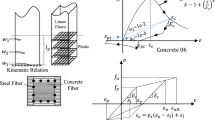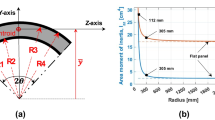Abstract
Reinforced concrete (RC) wall is a common type of structural component used in high-rise buildings to resist lateral loads induced by earthquakes. RC walls are typically designed and detailed to dissipate energy through significant inelastic responses to meet expected seismic performance under moderate-to-strong earthquakes. However, costly repair or even demolition caused by excessive residual deformation is usually inevitable. Given this deficiency, this study investigates the feasibility of utilizing superelastic shape memory alloy (SMA) bars to achieve self-centering (SC) RC walls. Under this condition, the residual deformation of SC–RC walls is reduced by superelastic SMA with large recoverable strain and remarkable fatigue properties. The mechanical properties of superelastic nickel–titanium bars and SC–RC wall design are described. A numerical SC–RC wall model is developed and validated by comparing the test results. Parametric studies of SC–RC wall systems are then conducted to investigate the effects of axial compressive load ratio, bottom slit length, and lower plateau stress factor of SMA. Results show that the proposed SC–RC walls have excellent SC ability and moderate energy dissipation capacity. The damage regions and levels of the SC–RC wall systems are also discussed.




















Similar content being viewed by others
References
ACI (American Concrete Institute) (2008) Acceptance criteria for special unbonded post-tensioned precast structural walls based on validation testing. ACI ITG-5.1-07, Farmington Hills, MI
ACI (American Concrete Institute) (2014) Building code requirements for structural concrete (ACI 318-14) and commentary on building code requirements for structural concrete (ACI 318R-14). ACI Committee 318, Farmington Hills, MI
Alam MS, Nehdi M, Youssef MA (2009) Seismic performance of concrete frame structures reinforced with superelastic shape memory alloys. Smart Struct Syst 5(5):565–585
Araki Y, Shrestha KC, Maekawa N, Koetaka Y, Omori T, Kainuma R (2016) Shaking table tests of steel frame with superelastic Cu-Al-Mn SMA tension braces. Earthq Eng Struct D 45(2):297–314
Bradley BA, Dhakal RP, Mander JB, Li L (2008) Experimental multi-level seismic performance assessment of 3D RC frame designed for damage avoidance. Earthq Eng Struct D 37(1):1–20
Bruneau M, Reinhorn A (2007) Exploring the concept of seismic resilience for acute care facilities. Earthq Spectra 23(1):41–62
Casciati S, Faravelli L (2008) Structural components in shape memory alloy for localized energy dissipation. Comput Struct 86(3):330–339
Casciati S, Faravelli L (2009) A passive control device with SMA components: from the prototype to the model. Struct Control Hlth 16(7–8):751–765
Casciati S, Faravelli L, Vece M (2017) Investigation on the fatigue performance of Ni-Ti thin wires. Struct Control Hlth 24(1):e1855
CEN (European Committee for Standardization) (2004) Design of structures for earthquake resistance- Part 1: General rules, seismic actions and rules for buildings. Eurocode 8, Brussel, Belgium
Chang GA, Mander JB (1994) Seismic energy based fatigue damage analysis of bridge columns: Part I-Evaluation of seismic capacity. Technical Report NCEER-94-0006, Multidisciplinary Center for Earthquake Engineering Research, University at Buffalo, New York
DesRoches R, McCormick J, Delemont M (2004) Cyclic properties of superelastic shape memory alloy wires and bars. J Struct Eng 130(1):38–46
Di Cesare A, Ponzo FC, Nigro D, Pampanin S, Smith T (2017) Shaking table testing of post-tensioned timber frame building with passive energy dissipation systems. Bull Earthq Eng. doi:10.1007/s10518-017-0115-9
Dolce M, Cardone D, Ponzo FC (2007) Shaking-table tests on reinforced concrete frames with different isolation systems. Earthq Eng Struct D 36(5):573–596
Erochko J, Christopoulos C, Tremblay R, Choi H (2011) Residual drift response of SMRFs and BRB frames in steel buildings designed according to ASCE 7-05. J Struct Eng 137(5):589–599
Fang C, Yam MCH, Lam ACC, Xie LK (2014) Cyclic performance of extended end-plate connections equipped with shape memory alloy bolts. J Constr Steel Res 94:122–136
FEMA (Federal Emergency Management Agency) (2012) Seismic performance assessment of buildings: volume 1-methodology, FEMA P-58-1, Washington, D.C
Graesser EJ, Cozzarelli FA (1991) Shape-memory alloys as new materials for aseismic isolation. J Eng Mech 117(11):2590–2608
Guerrini G, Restrepo JI, Vervelidis A, Massari M (2015) Self-centering precast concrete dual-steel-shell columns for accelerated bridge construction: seismic performance, analysis, and design. Technical Report 2015/13, Pacific Earthquake Engineering Research Center, University of California, Berkeley, California
Guo T, Zhang GD, Chen C (2014) Experimental study on self-centering concrete wall with distributed friction devices. J Earthq Eng 18(2):214–230
Hashemi A, Masoudnia R, Quenneville P (2016) Seismic performance of hybrid self-centring steel-timber rocking core walls with slip friction connections. J Constr Steel Res 126:201–213
Henry RS, Sritharan S, Ingham JM (2016a) Finite element analysis of the PreWEC self-centering concrete wall system. Eng Struct 115:28–41
Henry RS, Sritharan S, Ingham JM (2016b) Residual drift analyses of realistic self-centering concrete wall systems. Earthq Struct 10(2):409–428
Holden T, Restrepo J, Mander JB (2003) Seismic performance of precast reinforced and prestressed concrete walls. J Struct Eng 129(3):286–296
Iqbal A, Pampanin S, Palermo A, Buchanan AH (2015) Performance and design of LVL walls coupled with UFP dissipaters. J Earthq Eng 19(3):383–409
JRA (Japan Road Association) (2002) Design specifications of highway bridges, Tokyo
Kam WY, Pampanin S, Palermo A, Carr AJ (2010) Self-centering structural systems with combination of hysteretic and viscous energy dissipations. Earthq Eng Struct D 39(10):1083–1108
Kowalsky MJ (2000) Deformation limit states for circular reinforced concrete bridge columns. J Struct Eng 126(8):869–878
Kramer A, Barbosa AR, Sinha A (2016) Performance of steel energy dissipators connected to cross-laminated timber wall panels subjected to tension and cyclic loading. J Struct Eng 142(4):E4015013
Lu XL, Dang XL, Qian J, Zhou Y, Jiang HJ (2017) Experimental study of self-centering shear walls with horizontal bottom slits. J Struct Eng 143(3):04016183
Ma HW, Cho CD (2008) Feasibility study on a superelastic SMA damper with re-centring capability. Mat Sci Eng A 473(1–2):290–296
Mander JB, Cheng C-T (1997) Seismic resistance of bridge piers based on damage avoidance design. Technical Report NCEER-97-0014, U.S. National Center for Earthquake Engineering Research (NCEER), Dept. of Civil and Environmental Engineering, State Univ. of New York at Buffalo, Buffalo, NY
Mansour M, Hsu TTC (2005a) Behavior of reinforced concrete elements under cyclic shear. I: experiments. J Struct Eng 131(1):44–53
Mansour M, Hsu TTC (2005b) Behavior of reinforced concrete elements under cyclic shear. II: theoretical model. J Struct Eng 131(1):54–65
Marquis F, Kim JJ, Elwood KJ, Chang SE (2017) Understanding post-earthquake decisions on multi-storey concrete buildings in Christchurch. N Z B Earthq Eng 15(2):731–758
Mazzoni S, McKenna F, Scott MH, Fenves GL (2016) Open system for earthquake engineering simulation (OpenSees) command language manual (Available from: http://opensees.berkeley.edu/wiki/index.php/Command_Manual) Pacific Earthquake Engineering Research Center, Univ. of California, Berkeley, CA
McCormick J, Tyber J, DesRoches R, Gall K, Maier HJ (2007) Structural engineering with NiTi. II: mechanical behavior and scaling. J Eng Mech 133(9):1019–1029
McCormick J, Aburano H, Ikenaga M, Nakashima M (2008) Permissible residual deformation level for building structures considering both safety and human elements. In: Proceedings of the 14th World Conference on Earthquake Engineering, Beijing, China. Paper ID 05-06-0071
Mo YL, Zhong J, Hsu TTC (2008) Seismic simulation of RC wall-type structures. Eng Struct 30(11):3167–3175
NIST (National Institute of Standards and Technology) (2014) Recommendations for seismic design of reinforced concrete wall buildings based on studies of the 2010 Maule, Chile earthquake. NIST GCR 14-917-25, NEHRP Consultants Joint Venture, Gaithersburg, MD
Ozbulut OE, Silwal B (2016) Performance assessment of buildings isolated with S-FBI system under near-fault earthquakes. Smart Struct Syst 17(5):709–724
Paulay T, Priestley MJN (1993) Stability of ductile structural walls. ACI Struct J 90(4):385–392
Priestley MJN, Calvi GM, Kowalsky MJ (2007) Displacement-based seismic design of structures. IUSS Press, Pavia
Qian H, Li HN, Song GB (2016) Experimental investigations of building structure with a superelastic shape memory alloy friction damper subject to seismic loads. Smart Mater Struct 25(12):125025
Qiu CX, Zhu SY (2017) Shake table test and numerical study of self-centering steel frame with SMA braces. Earthq Eng Struct D 46(1):117–137
Restrepo J, Rahman A (2007) Seismic performance of self-centering structural walls incorporating energy dissipators. J Struct Eng 133(11):1560–1570
Saiidi MS, Wang HY (2006) Exploratory study of seismic response of concrete columns with shape memory alloys reinforcement. ACI Struct J 103(3):436–443
Saiidi MS, Sadrossadat-Zadeh M, Ayoub C, Itani A (2007) Pilot study of behavior of concrete beams reinforced with shape memory alloys. J Mater Civil Eng 19(6):454–461
Saiidi MS, O’Brien M, Sadrossadat-Zadeh M (2009) Cyclic response of concrete bridge columns using superelastic Nitinol and bendable concrete. ACI Struct J 106(1):69–77
Shook DA, Roschke PN, Ozbulut OE (2008) Superelastic semi-active damping of a base-isolated structure. Struct Control Hlth 15(5):746–768
Smith BJ, Kurama YC, McGinnis MJ (2011) Design and measured behavior of a hybrid precast concrete wall specimen for seismic regions. J Struct Eng 137(10):1052–1062
Speicher MS, DesRoches R, Leon RT (2011) Experimental results of a NiTi shape memory alloy (SMA)-based recentering beam-column connection. Eng Struct 33(9):2448–2457
Sritharan S, Aaleti S, Henry RS, Liu KY, Tsai KC (2015) Precast concrete wall with end columns (PreWEC) for earthquake resistant design. Earthq Eng Struct D 44(12):2075–2092
Tazarv M, Saiidi MS (2015) Reinforcing NiTi superelastic SMA for concrete structures. J Struct Eng 141(8):04014197
Thomsen JH, Wallace JW (1995) Displacement-based design of reinforced concrete structural walls: Experimental studies of walls with rectangular and T-shaped cross sections. Rep. No. CU/CEE-95/06, Department of Civil and Environmental Engineering, Clarkson University, Potsdam, N.Y
Thomsen JH, Wallace JW (2004) Displacement-based design of slender reinforced concrete structural walls-experimental verification. J Struct Eng 130(4):618–630
Toranzo LA, Restrepo JI, Mander JB, Carr AJ (2009) Shake-table tests of confined-masonry rocking walls with supplementary hysteretic damping. J Earthq Eng 13(6):882–898
Torra V, Carreras G, Casciati S, Terriault P (2014) On the NiTi wires in dampers for stayed cables. Smart Struct Syst 13(3):353–374
Tzimas AS, Kamaris GS, Karavasilis TL, Galasso C (2016) Collapse risk and residual drift performance of steel buildings using post-tensioned MRFs and viscous dampers in near-fault regions. B Earthq Eng 14(6):1643–1662
Vasdravellis G, Karavasilis TL, Uy B (2013) Finite element models and cyclic behavior of self-centering steel post-tensioned connections with web hourglass pins. Eng Struct 52:1–16
Wang W, Fang C, Liu J (2017) Self-centering beam-to-column connections with combined superelastic SMA bolts and steel angles. J Struct Eng 143(2):04016175
Wikipedia (2017) https://en.wikipedia.org/wiki/Hotel_Grand_Chancellor,_Christchurch
Wolski M, Ricles JM, Sause R (2009) Experimental study of a self-centering beam-column connection with bottom flange friction device. J Struct Eng 135(5):479–488
Youssef MA, Alam MS, Nehdi M (2008) Experimental investigation on the seismic behavior of beam-column joints reinforced with superelastic shape memory alloys. J Earthq Eng 12(7):1205–1222
Zhang Y, Zhu S (2007) A shape memory alloy-based reusable hysteretic damper for seismic hazard mitigation. Smart Mater Struct 16(5):1603–1613
Zhang YF, Zhu SY (2008) Seismic response control of building structures with superelastic shape memory alloy wire dampers. J Eng Mech 134(3):240–251
Zhu S, Zhang Y (2007) Seismic behaviour of self-centring braced frame buildings with reusable hysteretic damping brace. Earthq Eng Struct D 36(10):1329–1346
Zhu SY, Zhang YF (2008) Seismic analysis of concentrically braced frame systems with self-centering friction damping braces. J Struct Eng 134(1):121–131
Acknowledgements
The authors are grateful for the financial support from the Research Institute for Sustainable Urban Development of Hong Kong Polytechnic University (Project No. 4-ZZCG), the State Key Laboratory of Subtropical Building Science (South China University of Technology, Grant No. 2017ZA02) and Chinese National Engineering Centre for Steel Construction (Hong Kong Branch). The findings and opinions expressed in this paper are solely those of the authors and do not represent the views of the sponsors.
Author information
Authors and Affiliations
Corresponding author
Rights and permissions
About this article
Cite this article
Wang, B., Zhu, S. Seismic behavior of self-centering reinforced concrete wall enabled by superelastic shape memory alloy bars. Bull Earthquake Eng 16, 479–502 (2018). https://doi.org/10.1007/s10518-017-0213-8
Received:
Accepted:
Published:
Issue Date:
DOI: https://doi.org/10.1007/s10518-017-0213-8




